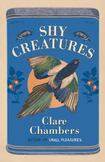
The first half of the 1990s were some of my happiest reading years, with debuts by Rachel Cusk, Nick Hornby, Kate Atkinson and Louise Doughty all finding long-term homes on my bookshelf. Clare Chambers’s 1992 debut, Uncertain Terms, and its follow-up, Back Trouble, were favourites too. I had always assumed her subsequent career was one of consistent success, so it was a surprise to read that she wrote Small Pleasures (published in 2020) from what she describes as, “a position of weakness and no great confidence, having been unpublished for many years, with my backlist barely in print.”
Small Pleasures, inspired by the true story of a German woman who claimed to have undergone a virgin birth, was a hit with critics and readers alike, and longlisted for the Women’s Prize for Fiction in 2021. Chambers has said her new book, has the “unenviable status” of being regarded as a second novel, yet it is actually her 10th.
Shy Creatures is not a companion piece to Small Pleasures, though it too has real-world origins: in the 1950s, police in Bristol found a man secretly living with an elderly aunt, his existence unrecorded by authorities and unnoticed by neighbours. Chambers moves this discovery forward by a decade and to London, beginning the story with Helen Hansford, an art therapist at a psychiatric hospital. Helen, a smart single woman in her 30s, has little in common with her family aside from her teenage niece Lorraine, who also enjoys art. Helen is having an affair with a married colleague, Gil, a charismatic psychiatrist who models himself on RD Laing.
This relationship is, “a series of peaks and troughs; for every high a corresponding love, the thrill of anticipation inevitably followed by an equivalent plunge in spirits. There was always a reckoning: fate had to balance its books.” Doggedly pragmatic Helen is committed to making her sidelined existence work until such time as Gil leaves his wife, which he has promised to do when his children are older.
READ MORE
One spring afternoon, the hospital is notified about a disturbance at a partially derelict house five miles away. A mute 37-year-old man called William Tapping, his beard grown down to his waist, has been discovered at his aunt Louisa’s home. Louisa is ill and admitted to hospital, William to Westbury Park. When Helen visits Louisa to discuss William, the conversation haunts her: “The answers were so matter-of-fact, so cheerfully delivered, so very nearly rational, and yet somewhere beneath them lay the wreckage of a man’s life.” Helen realises William is a talented artist, and begins to explore his background in the hopes of finding workable sources of support for him.
Shy Creatures initially appears to be the story of Helen and charming narcissist Gil, and “the tired old treads of their relationship”, but as the Tapping family story begins to weave around Helen’s own, her professional and personal lines become blurred. Moving fluently between 1964 and decades earlier, the novel reveals the secrets of William’s uneasy early life with three spinster aunts. He is a sweet-natured, naive and literal-minded child, who makes a friend at boarding school when they are the only two boys horrified at the sight of a classmate battering a terrified baby mouse until it is “smashed to a pink paste”. While Helen is learning about the Tappings, she is simultaneously forced to confront the reality of a future as Gil’s secret lover: “all of her minuscule acts of kindness, charity, unselfishness were like grains of sand dropped into the scale to try and balance the great boulder of Wrong that she perpetrated every day against Kath and The Children”.
Aside from overly confident Gil, Chambers’s characters are either timid, trapped by a troubled childhood, or uncertain, watching and waiting in the margins. One of the novel’s many pleasures is how convincingly unswinging 1964 is: rationing remains a recent memory, Helen prefers the Third Programme to pop, and Lorraine’s parents are horror-struck by their daughter’s desire for a life different from theirs. Since Uncertain Terms, Chambers’s books have been characterised by extraordinary insights into so-called ordinary lives. That she is often described as the author of historical romance novels strikes me as both reductive and unnecessary: she writes with honesty and compassion about human experience, and the redemptive power of love and kindness. William is particularly memorable, and it’s impossible to read Shy Creatures without fervently wishing a happy childhood for him, even if he has to wait until adulthood for it.















